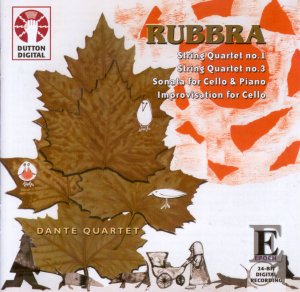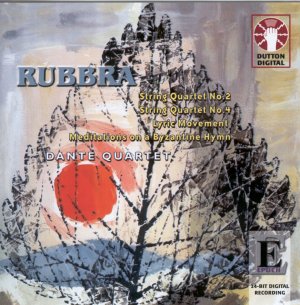These two discs are only available separately. However
it seemed logical and opportune to weave together a single review now
that the second of the two discs has been issued.
The heart of the above pair of discs is the complete
string quartets of Edmund Rubbra. This is not the first time they have
been recorded as a cycle. In the early 1990s, while Conifer were still
buoyant, that company recorded the four in a slackly filled two CD set.
The young quartet involved was the Sterling. I do not have the Conifer
(deleted a couple of years ago and long unavailable) but I do recall
that it had more of a distantly recorded perspective than the present
Dutton project.
While the First Quartet is dedicated to Vaughan
Williams don't for one moment imagine that it will sound entirely like
that composer although there are a few fleeting moments where if coasts
close to that green and pleasant land. For the most part though this
is a work that is of a piece with Rubbra’s own First Symphony and then
with the much later Piano Concerto. After an insistently morose lento
the finale launches one of those typical ostinati over which Rubbra
pitches a quick-running vital sinuous tune; this time with much in common
with the Fifth Symphony.
The Second Quartet is in four movements, the
first and third being markedly longer than the other two: 8:39; 2:37;
7:31; 3:55. It was premiered in 1952 by the Grillers; the same quartet
that premiered Bax's Third in the mid-1930s. The character of the two
quartets (Bax’s and Rubbra’s) could hardly be more different: Bax, highly
spiced, poetic and dramatic; Rubbra, Beethovenian, earnest, the abnegation
of ornament. This monastic severity carries over into the ‘inscape’
of the Cavatina which is an evolution of the adagios of Beethoven's
last quartets. There are some lovely things in this quartet but its
character overall seems too diffuse - something that cannot be said
of Rubbra’s Third.
The Third Quartet was a child (albeit a wise
and knowing child) of the 1960s. Intense, grave, dense and then skittish.
Overall though this is once again a work of Beethovenian introspection
despite an allegro leggiero that flies Tippett-like through the
Dark Night of the Soul. It ends with a modestly confident gesture.
Rubbra's last quartet, the Fourth, is dedicated
to that other sombre symphonist and quartet writer, Robert Simpson.
Simpson, before he fell out with the BBC, was a doughty Rubbra and Brian
champion within the Corporation. It was as a result of his street-fighting
skills that Rubbra managed to secure various symphony broadcasts in
the 1960s and 1970s including key broadcasts of the symphonies by Groves
(1 and 2) and Malcolm Arnold (3 and 4). The Fourth was premiered by
the Amici who were, in 1978, to record Bax's Third Quartet for Lewis
Foreman’s Gaudeamus LP label. The Rubbra is in two concentrated movements
vital with both dancing and serious material. John Pickard reminds us
that the themes and their treatment are related to the composer's wonderful
Eleventh Symphony - itself a miracle of succinctly communicated drama.
In the second movement of the quartet the music rises inexorably to
a shiningly substantial shudderingly heroic statement (5.32, tr.8) before
settling into sempiternal silence. The following downward curvature
is almost too steep. I do wonder whether that subsiding should have
been more protracted. Is this at the door of Rubbra or of the Dantes?
Concise expression is the order of the day in the Eleventh Symphony
where form and substance are perfectly matched and resolved. Rubbra
could have allowed himself more time in the quartet to trace a steady
descent to silence - the sort of thing that the more discursive Pettersson
and Hovhaness managed with a surer touch.
The six minute Improvisation is typically
serious Rubbra. It prompts thoughts of the Bach suites for solo cello,
of the amber-toned reflections of Bax's Rhapsodic Ballad and
of the uncanny closeness the Finzi Cello Concerto.
The Cello Sonata has that trademark occluded
lyricism. It begins with all the potency of Rubbra's beetling Soliloquy
(cello and orchestra - recorded by Rohan de Saram on a Lyrita LP). Rather
like the Improvisation this too might occasionally remind you
of the Finzi Cello Concerto both in its singing lines and its Bachian
contouring. The movements are laid out, slow - fast - slow.
The Lyric Movement is a single movement
piece - the earliest across these two discs. It represents a path that
was fully subsumed into his mature style. This is Rubbra in densely
pastoral style shadowing the Howells of the Fantasy String Quartet
and even more so of the Piano Quartet. The form is instantly recognisable
as a Cobbett ‘phantasy’ although that name does not appear in the title.
The Byzantine Meditation was written
for Maurice Loban, originally for solo viola, who premiered it in December
1962. Rubbra later arranged it for two violas as featured here. It is
the most severe work across the two discs with little in the way of
surface attraction or varied drama. The work perhaps owes something
to the austere Holst - say in the Lyric Movement for viola and
the Four Songs for voice and solo violin although, in fairness
to readers, those two works have a more open lyrical heart than this
work.
Wonderful discs making available vibrant and sincerely
expressed music of unaffected profundity well supported in each case
by the booklet notes and by the closely engaged recording.
Rob Barnett


![]() Michael Dussek (piano)
Michael Dussek (piano)
![]() DUTTON EPOCH CDLX
7123 [71.41]
DUTTON EPOCH CDLX
7123 [71.41] ![]() Michael Dussek (piano)
Michael Dussek (piano)
![]() DUTTON EPOCH CDLX
7114 [59.13]
DUTTON EPOCH CDLX
7114 [59.13]